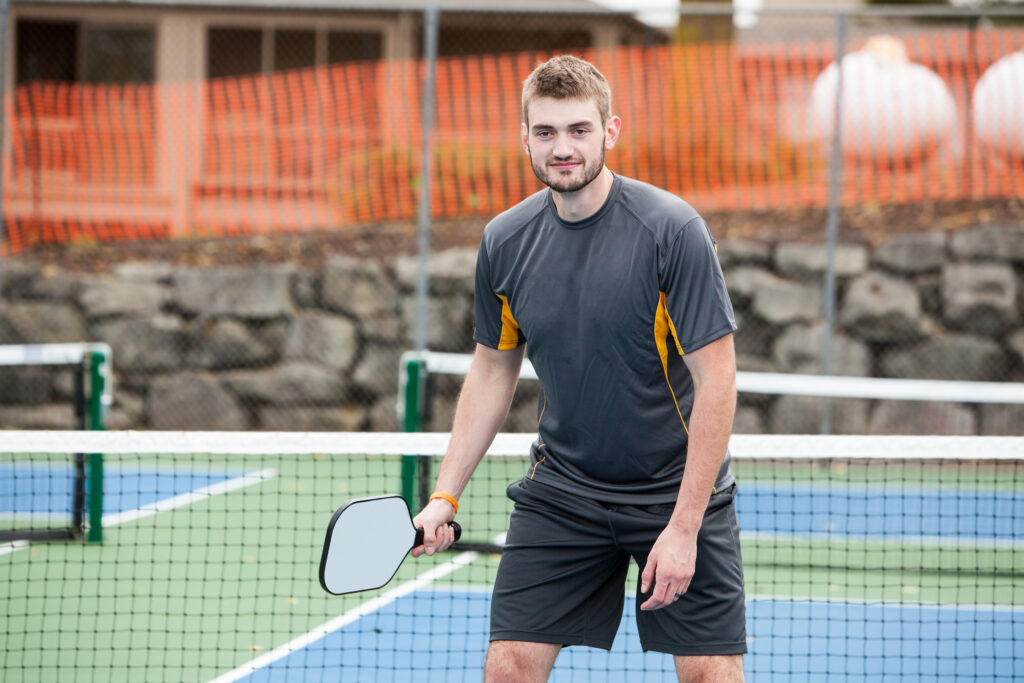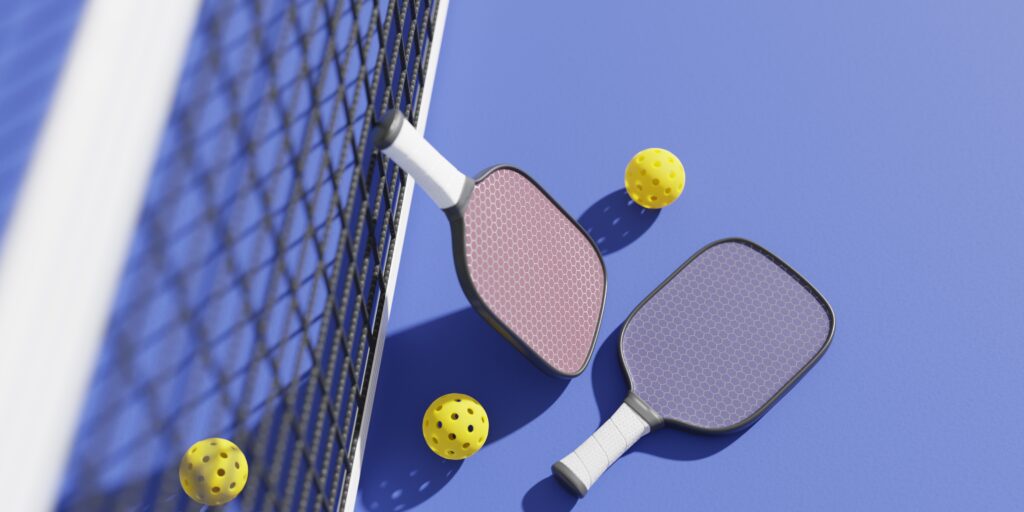Pickleball
What Are Pickleball Paddles Made Of? 5 Common Paddle Materials
Pickleball, a popular paddle sport that combines elements of tennis, badminton, and table tennis, is rapidly gaining popularity as one of America’s favorite recreational sports, attracting many newcomers excited to join in.
One of the most critical pieces of gear is the pickleball paddle. With so many people taking up the sport, the question arises: What are pickleball paddles made of?
Knowing what your paddle is crafted from is super important when you’re on the hunt for the perfect one. It helps you pick the right fit for your playing style, skill level, and what you personally like.
In this blog, we’ll take a closer look at the specifics of what a pickleball paddle is made of.

Pickleball Paddle Materials
Pickleball paddles come in various shapes, sizes, and materials, but the most common ones are made of composite materials, wood, graphite or fiberglass. Each material offers its unique advantages and characteristics that cater to different playing styles and skill levels.
Continue reading to uncover all the essential information about the composition of pickleball paddles!

1. Graphite Paddles
- Preferred Players: Graphite paddles are a top choice among players who prioritize precision, control, and agility on the court. These paddles are often favored by intermediate to advanced players.
- Pros:
- Lightweight Advantage: Graphite paddles are known for their featherweight construction, enabling players to react swiftly and make precise shots.
- Exceptional Control: The smooth graphite surface allows for outstanding control and finesse, facilitating accurate placement of shots.
- Spin-Friendly: The surface is conducive to spin control, allowing players to put a desirable spin on the ball.
- Cons:
- Power Limitation: Graphite paddles may lack the raw power of some other materials, making them less suitable for players who rely heavily on power shots.
- Less Forgiving: Off-center hits may result in less forgiving ball contact and reduced shot effectiveness.
- Average Price: $50 to $150
2. Fiberglass Paddles
- Preferred Players: Fiberglass paddles are appreciated by players who seek a balanced blend of control and power. They are versatile and suit a broad range of players, including intermediates and some advanced players.
- Pros:
- Moderate Texture: Fiberglass surfaces provide a moderate amount of texture, contributing to effective spin control.
- Versatility: These paddles adapt well to different playing styles, offering a combination of control and pop.
- Wide Appeal: Their versatility makes them suitable for players with varying skill levels and playing preferences.
- Cons:
- Power Constraints: Fiberglass paddles may not deliver the same level of power as carbon fiber or composite options, which could be a limitation for power-oriented players.
- Performance Limitations: They may not excel in extreme aspects of power or control, potentially leaving players seeking specialized attributes wanting more.
- Average Price: $40 to $120

3. Carbon Fiber Paddles
- Preferred Players: Carbon fiber paddle surfaces are the choice of aggressive players who rely on powerful shots and quick responsiveness. These paddles are often seen in the hands of advanced and competitive players.
- Pros:
- Dominant Power: Carbon fiber paddles are renowned for their exceptional power and precision, allowing players to deliver powerful shots with precision.
- Responsiveness: The stiffness and responsiveness of these paddles facilitate quick ball response and impressive control during aggressive play.
- Ideal for Aggressive Play: They are excellent for driving the ball aggressively and maintaining control over shots.
- Cons:
- Less Forgiving: Similar to graphite, carbon fiber paddles may be less forgiving on off-center hits, requiring precise ball contact for optimal performance.
- Heft and Maneuverability: They can be heavier and may pose maneuverability challenges for some players.
- Average Price: $70 to $200
4. Composite Paddles
- Preferred Players: Composite paddle surfaces blend various materials, such as fiberglass, carbon fiber, or others, to offer a well-rounded playing experience. These paddles appeal to players of diverse skill levels.
- Pros:
- Balanced Performance: Composite paddles strike a balance between power, control, and spin, catering to a broad spectrum of playing styles.
- Versatile Adaptability: They are versatile and adaptable, making them suitable for different opponents and varying court conditions.
- All-Around Excellence: These paddles offer good all-around performance and are a dependable choice for players seeking versatility.
- Cons:
- Lack of Specialization: Composite paddles may not excel in any specific aspect compared to paddles with specialized materials.
- Performance Variability: The quality of performance can vary depending on the specific composite blend used in paddle construction.
- Average Price: $50 to $150
5. Wood Paddles
- Preferred Players: Wooden paddle surfaces, while less common, offer a classic and traditional feel, often appealing to recreational or vintage-style players.
- Pros:
- Classic Aesthetic: Wooden paddles provide a timeless and classic appearance that some players find aesthetically appealing.
- Moderate Attributes: They offer moderate power and control, suitable for players who enjoy a traditional paddle feel.
- Nostalgia Factor: Wooden paddles may evoke a sense of nostalgia and connection to the roots of the sport.
- Cons:
- Power Limitation: Wooden paddles may generally lack the same level of power as modern materials, potentially limiting their effectiveness for aggressive play.
- Responsiveness: They may not offer the same level of responsiveness and control as composite or graphite paddles.
- Average Price: $10 to $60

Innovations in Paddle Design
As pickleball continues to grow in popularity, paddle manufacturers are constantly innovating to create paddles that enhance players’ performance. Some of the latest trends in paddle design include:
- Edge Guards: Many modern paddles feature edge guards made of durable materials like rubber or polymer. These guards protect the paddle’s edges from damage and extend its lifespan.
- Honeycomb Core Technology: Honeycomb core paddles, typically constructed with Nomex or polymer, offer a unique combination of power and control. The honeycomb pattern distributes impact force evenly across the paddle face, reducing vibrations and providing a consistent feel.
- Variable Weight Distribution: Paddles with variable weight distribution allow players to customize the feel of their paddle. By redistributing weight, players can achieve the perfect balance between power and control.

Understanding what pickleball paddles are made of is important because their materials and design can impact a player’s performance on the court. Whether you’re a recreational player or a competitive enthusiast, choosing the right paddle that suits your playing style is essential.
When selecting a pickleball paddle, consider factors like your skill level, playing style, and personal preferences. Try out different paddles to find the one that feels most comfortable and effective for your game. Remember that pickleball paddles are made of various materials, each offering unique benefits.
If you’re in search of top-notch pickleball paddles, be sure to check out these options! The best pickleball paddle for you may not be the same as someone else’s, so explore your options and enjoy the game!




















